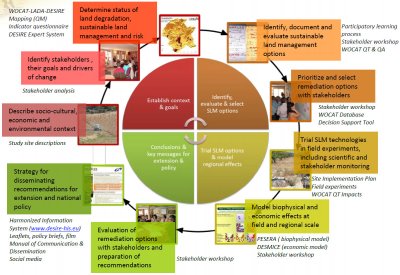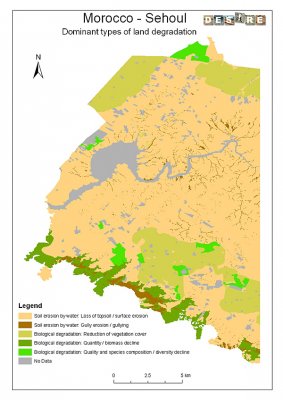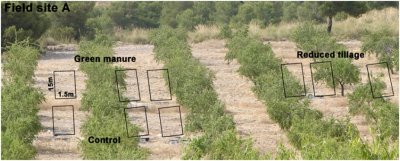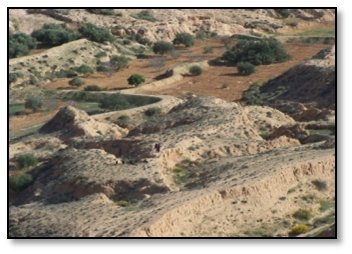| DESIRE Project Executive Summary: the need for sustainable land management |
 |
|
The need for sustainable land management
This is particularly the case in dryland areas, which are especially vulnerable to overexploitation, inappropriate land use, and climate change. Bad land management – including overgrazing and inappropriate irrigation and deforestation practices – often undermines land’s productivity. In dryland areas, land degradation is referred to as desertification. It encompasses soil erosion by water and wind, physical soil deterioration (e.g. compaction, crusting, and sealing), chemical soil deterioration (e.g. fertility decline and salinization), biological degradation (e.g. biomass and vegetation cover decline as well as forest fires), and water degradation (e.g. aridification).
The DESIRE response to desertification
The DESIRE approach was applied in 17 areas affected by desertification, accounting for a wide variety of biophysical and socioeconomic conditions found worldwide (see also »Study sites). The DESIRE approach can be applied by agricultural advisors, government institutions, or in any project that aims to combat land degradation. To date, it has been incorporated in publications and initiatives by the United Nations Convention to Combat Desertification (UNCCD), the UN Food and Agriculture Organisation (FAO), and the Global Environment Facility (GEF).
Thanks to its potential for identifying needs and sharing knowledge in SLM, the WOCAT methodology is an important cornerstone of the DESIRE approach. Within the DESIRE project, WOCAT tools were adapted to map the current status of land degradation and conservation. Further, the tools were integrated with a stakeholder learning approach and a decision support system for identifying, documenting, and selecting SLM strategies. The WOCAT databases and tools, updated with the SLM options evaluated in DESIRE, are available online to a worldwide audience. Information on SLM options is thus standardised and collated facilitating the exchange of land management strategies to combat desertification.
Mapping land degradation and SLM
Land degradation negatively affected ecosystem services for almost all degraded areas. Provision of ecosystem services – such as production of food, fodder, wood, water, and energy – was most affected in mixed land use areas, followed by areas of cultivated land and grazing land. High negative impacts were observed regarding regulation of ecosystem services – such as water regulation and nutrient flows, carbon sequestration, pollination, and pest control – indicating that these require particular attention when developing and implementing remediation strategies.
SLM measures appeared most effective on cultivated land, but positive impacts positive impacts from SLM on ecosystem services were also recorded for relatively large areas of forest and grazing land. Overall, there appears to be scope for improving SLM contributions to ecosystem services in cultivated land.
SLM technologies and approaches There were 38 case studies investigated in the DESIRE project; 30 for SLM technologies and eight for SLM approaches. The physical practices used in the field to control land degradation and enhance productivity – the SLM technologies, in other words – could be divided into five groups: cropping management, water management, cross-slope barriers, grazing land management, and forest management. They addressed all the main types of land degradation. Most of them were applied on cropland, although grazing land is equally important – perhaps even more important in spatial terms – in drylands. Depending on the kind of degradation addressed, agronomic, vegetative, structural, or management measures were used, or some combination of these.
The main functions of the SLM technologies assessed included their ability to increase infiltration capacity, control runoff, and improve ground cover. Most of the technologies were applied by small-scale land users, a group that is often underestimated regarding investment and innovation, not to mention their role in worldwide agricultural production. Individual and regulated communal land ownership and land use rights facilitated the implementation of SLM, confirming the results of previous studies.
Low-cost technologies (mostly below 100 USD/ha) were mainly found in the groups of cropping management and grazing land management, though their maintenance costs can be considerable. The most expensive technologies (2,000–10,000 USD/ha) were related to water management; however, technologies in this group also bear the highest potential for increasing profits and their maintenance costs are usually relatively low, i.e., below 300 USD/ha/year. Analyses showed that nearly half of the land users earned most of their income outside of their farm. All the technologies were found to be profitable in the long run; however, half of them were found to be less profitable, or not profit- able at all, in the short run. It was found that land users typically pay one-third of the implementation costs and all of the maintenance costs. This suggests that providing funding for implementation of technologies – e.g., through revolving funds or payments for ecosystem services – could be an effective way of enhancing adoption among land users, since the costs of implementation may make such measures unprofitable in the short run.
The approaches were perceived to have impacts on SLM that ranged from moderate to great, and most were found to enhance people’s livelihoods, decrease poverty, and generally improve the situation of socially and economically disadvantaged groups. Land users’ main reasons for implementing SLM measures were related to expectations of increased production, profitability, and/or payments or subsidies. Environmental consciousness played a minor role. Land users’ motivation to implement SLM measures can likely be increased by making them more aware of environmental issues as well as short- and long-term advantages (such as increasing profitability), and enabling them to participate in assessing the benefits of SLM by including them in research.
Policy recommendations The main policy recommendations to emerge from the DESIRE project and the investigations of SLM options are closely related to the DESIRE approach. The recommendations and the approach emphasise: collaboration of scientists with stakeholders; the need to link local knowledge with the latest technologies emerging from the scientific community, using a structured participatory process with stakeholders; the need to include stakeholder-defined criteria for selecting SLM options; and the benefits of performing standardised assessments using WOCAT tools. The latter could also be used as a tool in the reporting of countries to UNCCD, and thus can contribute directly to the implementation of the UNCCD convention. Policy briefs, fact sheets and key messages (see »Key messages) are available.
|
|||||||||||||||||

Acknowledgement
The DESIRE project was
|
DESIRE brought together the expertise of
26 international research institutes
and non-governmental organisations.
This website does not necessarily
represent the opinion of the
European Commission. The European
Commission is not responsible for
any use that might be made of the
information contained herein. 
 Executive summary
Executive summary





